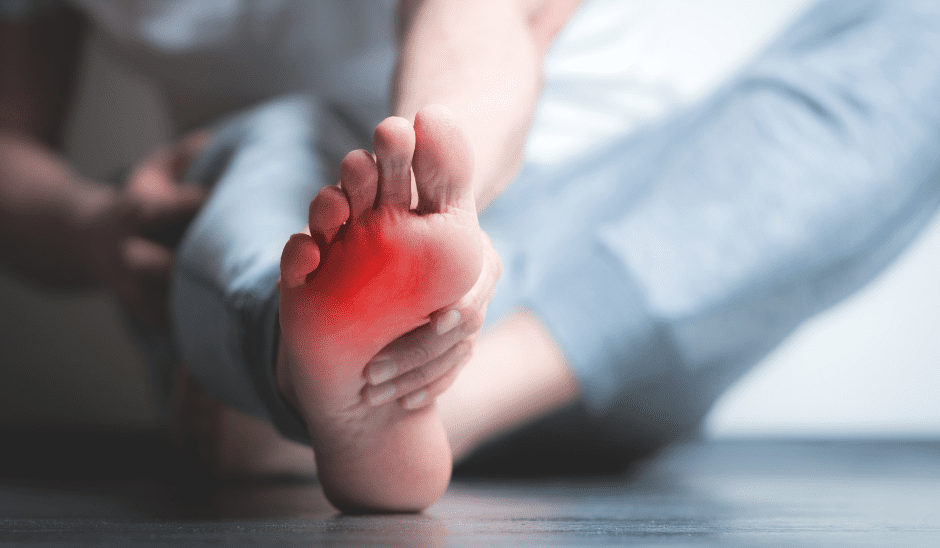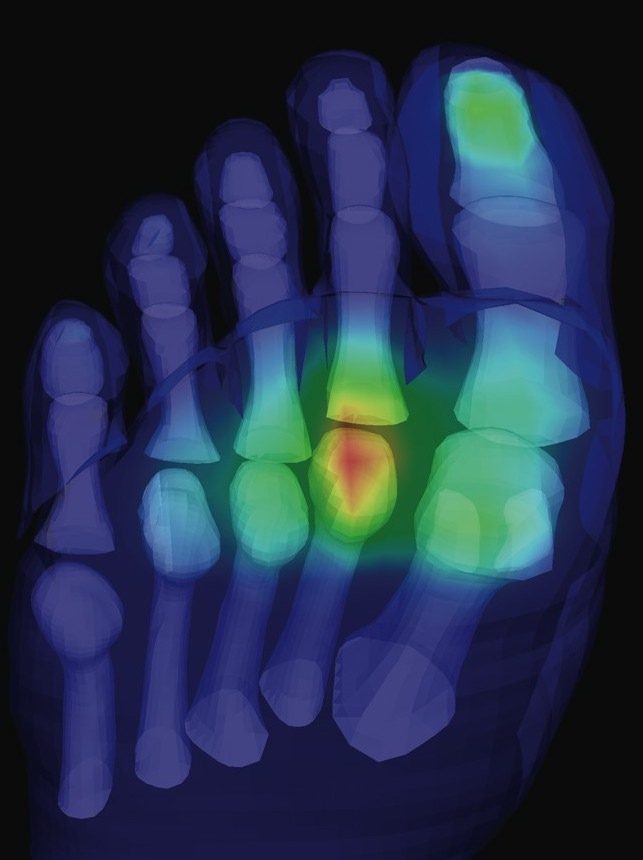
Jump to section
If you feel like you may be walking on a pebble in your shoe, or like there’s a rock underneath the ball of the foot, it may be a condition called capsulitis. Capsulitis is a common condition our podiatrists see and while it can affect any joint, it most commonly affects the second toe.
Like the name suggests, capsulitis means the inflammation (‘itis’) of a joint capsule. The joints in your feet are enveloped and contained within a capsule that helps the joint work smoothly and maintain a good alignment. When a capsule is damaged, the joint can become painful, swollen, and leave you feeling like you’re walking on a pebble. Capsulitis isn’t limited to the feet but can occur anywhere that a joint capsule is present, with a well-known capsulitis in the upper body being a frozen shoulder (adhesive capsulitis).
Joint pain arising from capsulitis is often caused by overloading the joint. This means that you place more pressure on the joint than it can handle, so damage occurs, and your pain starts. Your overloading is often linked to faulty foot mechanics, but may arise from wearing narrow, unsupportive or high-heeled shoes where the weight of your body is disproportionally loaded across the forefoot, going too hard too fast during physical activity, or abnormalities with your toe or foot structure or function. It’s not uncommon to find in a person with capsulitis of their second toe, that the second toe bone (metatarsal) is longer, and therefore takes on more pressure with each step, especially when pushing up off the ground.
Capsulitis is most common in women between the ages of 30-60 years, and you also have a higher risk of developing capsulitis if you:
As each person is unique in the stresses that are placed on their feet and joints, an assessment that uncovers exactly what’s happening with your feet is vital for effective treatment.
Capsulitis is often accompanied by:
Capsulitis can be effectively diagnosed in the clinic by your podiatrist through a physical assessment and examination of the foot. In some cases, medical imaging may be needed to rule out other causes of foot pain with similar symptoms but a different treatment approach, such as a Morton’s neuroma. This is also why it’s important to not to self-diagnose, as you may otherwise miss an important diagnosis that requires a different form of treatment - or urgent care.

Treating capsulitis involves removing the excess pressure and forces that caused the joint to become injured in the first place. This is where a comprehensive assessment with a podiatrist is crucial to a successful treatment, as they take the time to understand all of the contributing factors to your injury - otherwise you may spend weeks not getting the results you want due to an incomplete picture of the problem. Your treatment may include:
Surgery is not clinically indicated for capsulitis.
Here at The Feet People, we go above and beyond to ensure that every patient receives the very best care, and a carefully designed treatment plan that is unique to their individual circumstances. Our podiatrists understand that it’s about so much more than just pain in your foot, but that this pain interferes with your ability to do the things you love and achieve your goals. All of our treatments are focused on not only getting you out of pain, but also preventing the problem from recurring in the future. We stay with you every step of the way to help you get back to pain-free living, and treat every patient with the utmost care and respect.
Ignoring capsulitis can lead to the joint destabilising and producing some serious - and often irreversible - symptoms. This includes the joint becoming more prominent and therefore more prone to excess pressure, injury, corns, callus and pressure sores, as well as having the toes crossing over one another over time - as the joint capsule responsible for helping the joint maintain a healthy alignment is no longer functioning properly.
What is the difference between capsulitis and synovitis?
The terms ‘capsulitis’ and ‘synovitis’ are often used interchangeably, though they describe different aspects of joint capsule damage. Specifically, synovitis is the inflammation of the tissue that lines the joint capsule called the synovial membrane. This membrane is responsible for producing synovial fluid, which occurs in synovitis leading to additional swelling. Capsulitis describes damage to the outer joint capsule, as opposed to its inner lining. The two often go hand in hand.
| Monday | 7:30am - 6:30pm |
| Tuesday | 7:30am - 6:00pm |
| Wednesday | 7:30am - 6:30pm |
| Thursday |
7:30am - 6:00pm |
| Friday | CLOSED |
| Saturday | CLOSED |
| Sunday | CLOSED |
Ground Floor, 344 Queen Street,
Brisbane City QLD 4000
| Monday | 7:30am - 6:00pm |
| Tuesday | 7:30am - 6:00pm |
| Wednesday | 7:30am - 6:00pm |
| Thursday |
7:30am - 6:30pm |
| Friday | 7:30am - 5:30pm |
| Saturday | 7:30am - 4:30pm |
| Sunday | CLOSED |
Newmarket Village, 114/400 Newmarket Rd, Newmarket QLD 4051